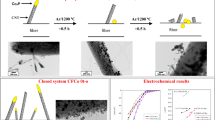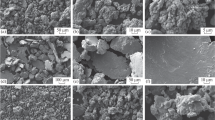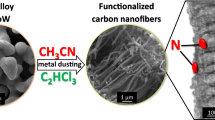Abstract
Novel two-dimensional carbon–carbon composites made of carbon nanofibers (CNFs) supported on a carbon preform were functionalized by non thermal plasma treatment (room temperature, atmospheric pressure, humid air), before being used as supports for metallic cobalt nanoparticles. It was shown that the degree of functionalization of the carbon nanofibers depends on the plasma power input, the treatment time and the CNF loading. The size of the cobalt nanoparticles generated after subsequent reduction of the Co-containing plasma treated CNF/C composites under hydrogen flow seems to be independent of the amount of supported cobalt. Changes in surface characteristics were analyzed using thermogravimetric analyses coupled to a mass spectrometer, X-ray photoelectron spectroscopy analyses and Raman spectroscopy. Transmission electron microscopy was used to complementary characterize the final size, dispersion and location of the so generated Co nanoparticles.










Similar content being viewed by others
References
Toebes ML, Van Heeswijk JMP, Bitter JH, Van Dillen AJ, De Jong KP (2004) The influence of oxidation on the texture and the number of oxygen containing surface groups of carbon nanofibers. Carbon 42(2):307–315
Zhang G, Sun S, Yang D, Dodelet JP, Sacher E (2008) The surface analytical characterization of carbon fibers functionalized by H2SO4/HNO3 treatment. Carbon 46(2):196–205
Ros TG, Van Dillen AG, Geus JW, Koningsberger DC (2002) Surface oxidation of carbon nanofibres. Chem Eur J 8(5):1151–1162
Xia W, Jin C, Jundu S, Muhler MA (2009) Highly efficient gas-phase route for the oxygen functionalization of carbon nanotubes based on nitric acid vapor. Carbon 47(3):919–922
Xing Y, Li L, Chusuei CC, Hull RV (2005) Sonochemical oxidation of multiwalled carbon nanotubes. Langmuir 21(9):4185–4190
Rasheed A, Howe JY, Dadmun MD, Britt PF (2007) The efficiency of the oxidation of carbon nanofibers with various oxidizing agents. Carbon 45(5):1072–1080
Bandosz TJ (2009) pp 45–92, In: Carbon materials for catalysis, Serp P and Figueiredo JL (Eds), Wiley: New York
Chen C, Liang B, Lu D, Ogino A, Wang X, Nagatsu M (2009) Oxygen functionalization of multiwall carbon nanotubes by microwave-excited surface-wave plasma treatment. J Phys Chem C 113(18):7659–7665
Felten A, Bittencourt C, Pireaux JJ, Van Lier G, Charlier JC (2005) Radio-frequency plasma functionalization of carbon nanotubes surface O2, NH3, and CF4 treatments. J Appl Phys 98:074308
Okpalugo TIT, Papakonstantinou P, Murphy H, Mclaughlin J, Brown NMD (2005) Oxidative functionalization of carbon nanotubes in atmospheric pressure filamentary dielectric barrier discharge (APDBD). Carbon 43(14):2951–2959
Naseh MV, Khodadadi AA, Mortazavi Y, Pourfayaz F, Alizadeh O, Maghrebi M (2010) Fast and clean functionalization of carbon nanotubes by dielectric barrier discharge plasma in air compared to acid treatment. Carbon 48(5):1369–1379
Lee S, Peng JW, Liu CH (2009) Probing plasma-induced defect formation and oxidation in carbon nanotubes by Raman dispersion spectroscopy. Carbon 47(15):3488–3497
Xu L, Fang Z, Song P, Peng M (2010) Surface-initiated graft polymerization on multiwalled carbon nanotubes pretreated by corona discharge at atmospheric pressure. Nanoscale 2(3):389–393
Wen-Hui W, Bi-Chun H, Li-Shan W, Dai-Qi Y (2011) Oxidative treatment of multi-wall carbon nanotubes with oxygen dielectric barrier discharge plasma. Surf Coat Technol 205(21–22):4896–4901
Yu H, Cheng D, Williams TS, Severino J, De Rosa IM, Carlson L, Hicks RF (2013) Rapid oxidative activation of carbon nanotube yarn and sheet by a radio frequency, atmospheric pressure, helium and oxygen plasma. Carbon 57:11–21
Kolacyak D, Ihde J, Lommatzsch U (2011) Carbon nanotube functionalization by atmospheric pressure plasma and post-plasma reactions. Surf Coat Technol 205:S605–S608
Zaldivar RJ, Nokes JP, Adams PM, Hammoud K, Kim HI (2012) Surface functionalization without lattice degradation of highly crystalline nanoscaled carbon materials using a carbon monoxide atmospheric plasma treatment. Carbon 50:2966–2975
Santos AL, Botelho EC, Kostov KG, Nascente PAP, da Silva LLG (2013) Atmospheric plasma treatment of carbon fibers for enhancement of their adhesion properties. Plasma Sci, IEEE Trans 41(2):319–324
Rhee KY, Park SJ, Hui D, Qiu Y (2012) Effect of oxygen plasma-treated carbon fibers on the tribological behavior of oil-absorbed carbon/epoxy woven composites. Compos B Eng 43(5):2395–2399
Asedegbega-Nieto E, Guerrero-Ruiz A, Rodriguez-Ramos I (2006) Direct carbon patterning on a conducting substrate in an organic liquid. Carbon 44(4):799–823
Toebes ML, Zhang Y, Hájek J, Nijhuis TA, Bitter JH, Van Dillen AJ, Dmitry Yu, Murzin DY, de Jong KP (2004) Support effects in the hydrogenation of cinnamaldehyde over carbon nanofiber-supported platinum catalysts: characterization and catalysis. J Catal 226(1):215–225
Li Z, Liang C, Feng Z, Ying P, Wang D, Li C (2004) Ammonia synthesis on graphitic-nanofilament supported Ru catalysts. J Mol Cat A 211(1):103–109
Morales-Acosta D, Ledesma-Garcia J, Godinez LA, Rodríguez HG, Álvarez-Contreras L, Arriaga LG (2010) Development of Pd and Pd–Co catalysts supported on multi-walled carbon nanotubes for formic acid oxidation. J Power Sources 195(2):461–465
den Breejen JP, Radstake PB, Bezemer GL, Bitter JH, Froseth V, Holmen A, de Jong KP (2009) On the origin of the cobalt particle size effects in Fischer–Tropsch catalysis. J Am Chem Soc 131(20):7197–7203
Felten A, Ghijsen J, Pireaux J–J, Drube W, Johnson RL, Liang D, Hecq M, Van Tendeloo G, Bittencourt C (2009) Electronic structure of Pd nanoparticles on carbon nanotubes. Micron 40(1):74–79
Leghrib R, Pavelko R, Felten A, Vasiliev A, Cané C, Gràcia I, Pireaux JJ, Llobet E (2010) Gas sensors based on multiwall carbon nanotubes decorated with tinoxide nanoclusters. Sens Actuators, B 145(1):411–416
Larciprete R, Gardonio S, Petaccia L, Lizzit S (2009) Atomic oxygen functionalization of double walled C nanotubes. Carbon 47:2579–2589
Li X (2008) Functionalization of carbon nanofibers with diamine and polyimide oligmer. Carbon 46(8):1115–1125
Harris PJF (2009) Carbon nanotube science: synthesis, properties and applications. Cambrigde university Press, Cambrigde
Bezemer LG, Bitter JH, Kuipers HPEC, Oosterbeek H, Holewijn JE, Xu X, Kapteijn F, Jos van Dillen A, de Jong KP (2006) Cobalt particle size effects in the Fischer–Tropsch reaction studied with carbon nanofiber supported catalysts. J Am Chem Soc 128(12):3956–3964
Acknowledgments
The authors are grateful to the “FUI” program (French cross-ministerial fund) and to the AESE Valley—Régions Aquitaine et Midi-Pyrénées under the NAno COmposite MAterials (NACOMAT) consortium for their financial support. J. Souquet-Grumey gratefully acknowledges DGE and Snecma Propulsion Solide Company (SAFRAN Group) for his Ph.D. Grant. The authors gratefully thank S. Pronier (IC2MP/Poitiers) for his valuable technical help in the TEM imaging and 2D Fourier transform diffractograms analyses.
Author information
Authors and Affiliations
Corresponding authors
Rights and permissions
About this article
Cite this article
Souquet-Grumey, J., Ayrault, P., Heintz, O. et al. Non Thermal Plasma Functionalized 2D Carbon–Carbon Composites as Supports for Co Nanoparticles. Plasma Chem Plasma Process 34, 287–300 (2014). https://doi.org/10.1007/s11090-013-9514-0
Received:
Accepted:
Published:
Issue Date:
DOI: https://doi.org/10.1007/s11090-013-9514-0




